As a parent in our bustling digital world, you’re constantly juggling. You want to embrace the technology that helps your kids learn and play, but you’re also their chief protector. From navigating screen time rules to ensuring online safety, the list is endless. One crucial area that often gets overlooked, however, is right on their heads: their headphones.
Think about it: a long car ride made peaceful by an audiobook, a sibling quietly focused on an online class, or a moment of calm as your child enjoys their favorite cartoon. Headphones are modern parenting superheroes. But here’s a startling fact: according to the World Health Organization (WHO), over a billion young people worldwide are at risk of permanent, avoidable hearing loss due to unsafe listening practices. The standard headphones you might have lying around the house can easily reach volumes that cause irreversible damage to a child’s delicate, developing ears.
This isn’t about fear; it’s about empowerment. Choosing headphones specifically designed for children isn’t a luxury—it’s a fundamental part of their health and well-being. This guide will not only introduce you to the top 5 kid-friendly headphones that protect hearing but will also arm you with the knowledge to make the best choice for your family.
Table of Contents
The Unseen Danger: Why Hearing Protection is Non-Negotiable
Before we jump into the best gear, let’s truly understand the “why.” A child’s auditory system is not just a smaller version of an adult’s; it’s still under construction. The ear canal is smaller, which can amplify sound pressure levels, and the delicate hair cells in the inner ear (cochlea) that transmit sound signals to the brain are far more susceptible to damage from loud noise.
To put it in perspective, a normal conversation is about 60 decibels (dB). City traffic can be around 85 dB. A standard smartphone or tablet can output over 100-105 dB through headphones—a level that can cause damage in less than 15 minutes. The recommended safe limit for prolonged listening is 85 dB. Volume-limiting headphones act as a safety gate, preventing the audio from ever reaching those dangerous peaks.
Early hearing loss in children isn’t always obvious. It can manifest subtly as difficulty with speech, behavioral issues, or trouble focusing in school. By choosing safe headphones, you’re not just protecting their ears; you’re safeguarding their ability to learn, communicate, and connect with the world around them.
Your Buying Guide: What to Look For in Kid-Friendly Headphones
Navigating the market can be overwhelming. Let’s break down the key features that truly matter, turning you into a pro-shopper for your little one.
- Strict Volume Limiting: This is the most critical feature. Look for a hard-capped limit of 85 dB. Some models offer slightly higher settings (e.g., 94 dB) for noisy environments like airplanes, which is acceptable for short-term use, but 85 dB should be the standard.
- Supreme Comfort & Fit: If they’re not comfortable, they won’t be worn. Look for lightweight materials, plush and breathable ear cushions (protein leather or soft mesh are great), and an easily adjustable headband. The “clamping force” should be gentle enough to not cause pressure but firm enough to stay put.
- Indestructible Durability: Kids are the ultimate product testers. Headphones should be ableto withstand being dropped, twisted, stretched, and stuffed into a backpack. Look for flexible, non-toxic, BPA-free plastics and reinforced, braided cables that resist tangling and breaking.
- Crystal-Clear Sound Quality: Safe volume doesn’t have to mean bad audio. Quality headphones deliver a balanced sound profile—clear vocals and highs without overwhelming, muddy bass. This prevents the temptation for kids to crank the volume to “hear better.”
- Wired vs. Wireless (Bluetooth):
- Wired: Pros – No charging needed, universally compatible, often more affordable. Cons – Cables can tangle, break, or be a snagging hazard for very young children.
- Wireless: Pros – Total freedom of movement, no tangles. Cons – Requires charging, potential for Bluetooth pairing hiccups. Many of the best models offer both options for ultimate flexibility.
- The “SharePort” Feature: This is a genius innovation. It’s an extra audio jack on one of the earcups that allows another headphone to plug directly in, letting two or more kids listen from the same device. No more fighting or clumsy splitters!
- Ease of Cleaning: Crumbs, sticky fingers—you name it. Headphones with smooth surfaces and durable ear cushions that can be easily wiped down are a huge plus for parents.
Our Top 5 Kid-Friendly Headphones That Protect Hearing
After extensive research, here are the top contenders that masterfully blend safety, durability, and kid-approved features.
1. Puro Sound Labs BT2200s: The Audiophile’s Choice for Safety
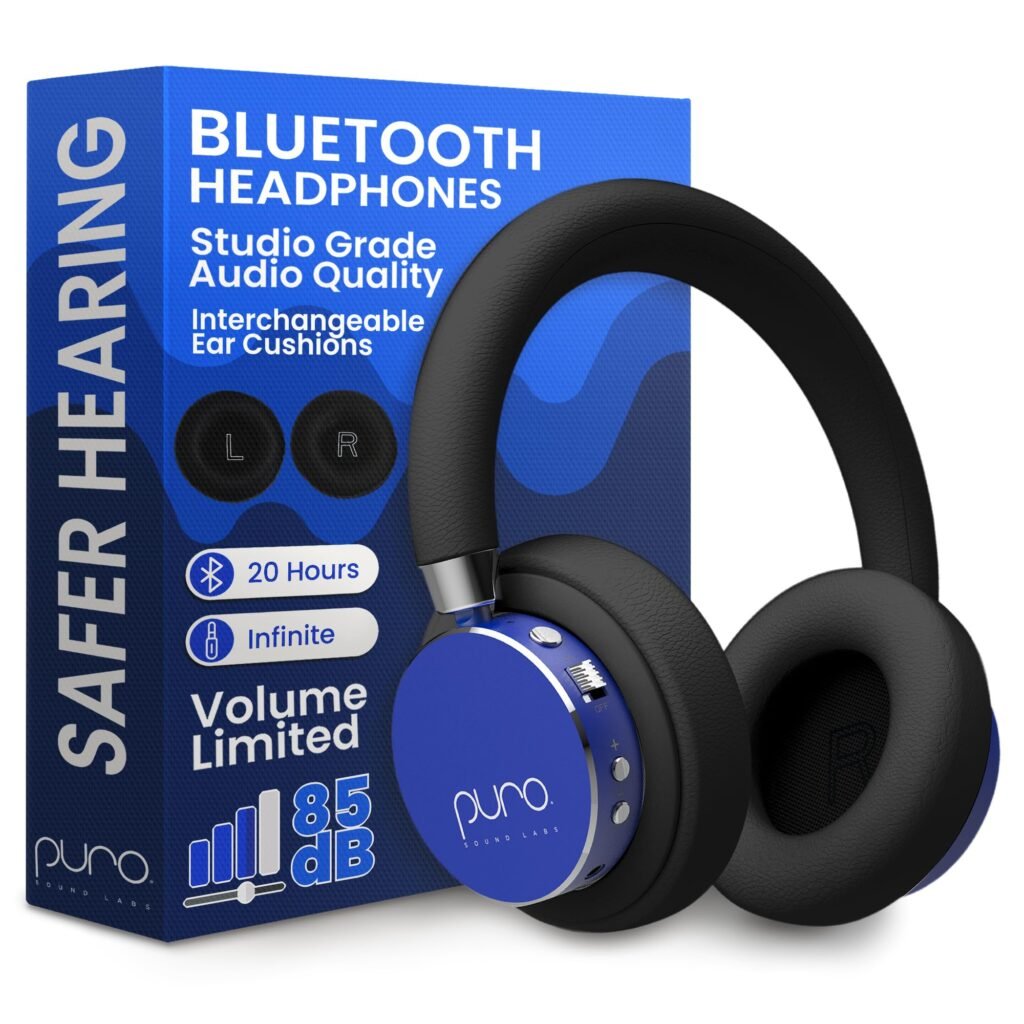
Why they’re a top pick: Puro Sound Labs was founded by a father who discovered his daughter had noise-induced hearing loss. Their mission is personal, and it shows. The BT2200s are the gold standard, offering studio-grade audio quality while strictly adhering to safety limits.
Key Features:
- Safe Volume Limit: An unbreachable 85 dB maximum.
- Puro Balanced Response® Curve: This isn’t just quiet audio; it’s clear audio. The technology is designed to deliver perfectly balanced sound with crisp vocals and full dynamic range at lower volumes, so kids never feel like they’re missing out.
- Superior Noise Isolation: The plush earcups block out an impressive 82% of ambient noise. This passive isolation means your child won’t need to turn up the volume to overcome background sounds in a car or on a plane.
- Dual Connectivity: Get up to 20 hours of playtime with Bluetooth 5.0, or use the included 3.5mm volume-limiting cable for a wired connection.
- Premium Build: Crafted with a lightweight yet durable aluminum frame and protein leather earcups, they feel and look like high-end adult headphones, which older kids love.
Perfect for: Parents who want zero compromises on sound quality and are willing to invest in the absolute best hearing protection technology on the market.
2. BuddyPhones PlayPlus: The Versatile All-Rounder
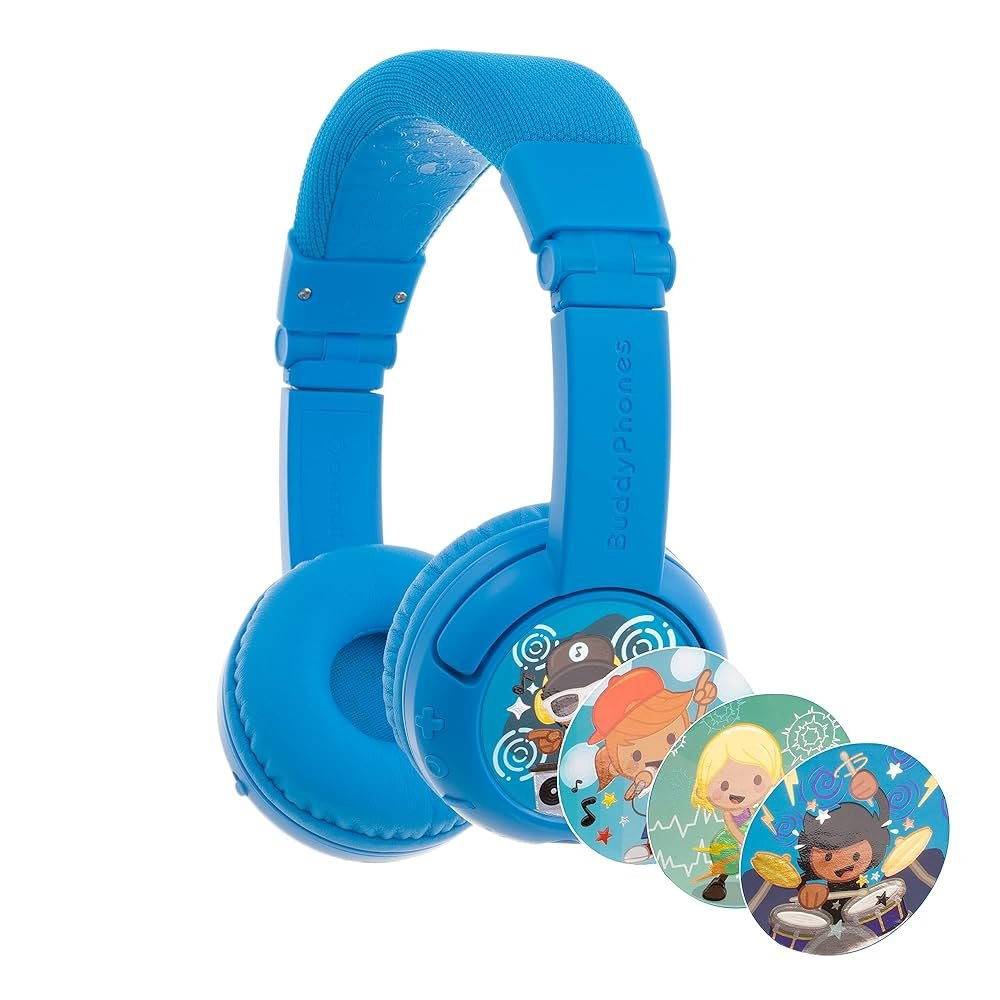
Why they’re a top pick: BuddyPhones are designed from the ground up with kids in mind, packed with clever features that make life easier for parents and more fun for children. The PlayPlus is their most popular and feature-rich model.
Key Features:
- 3-Mode SafeAudio®: This is its killer feature. Parents can choose the volume limit based on the environment: Toddler Mode (75 dB), Kids Mode (85 dB), and Travel Mode (94 dB) for noisy situations.
- BuddyLink™ Share Port: The integrated sharing port is incredibly convenient, allowing up to four kids to listen together from one device, fostering sharing and social play.
- Extreme Durability: Made from robust, flexible materials, these headphones can be bent and twisted without snapping. They are built to survive the playground.
- Kid-Focused Design: They come with a set of decorative stickers for personalization, a soft travel bag, and have a built-in microphone with a control button for calls or online classes.
- Long Battery Life: Offers 20 hours of wireless playtime and can also be used with the included cable.
Perfect for: Families on the go, parents of multiple children, and anyone who wants the flexibility of adjustable, parent-controlled volume limits.
3. JBL JR310BT: The Trusted Name with Big Battery Life
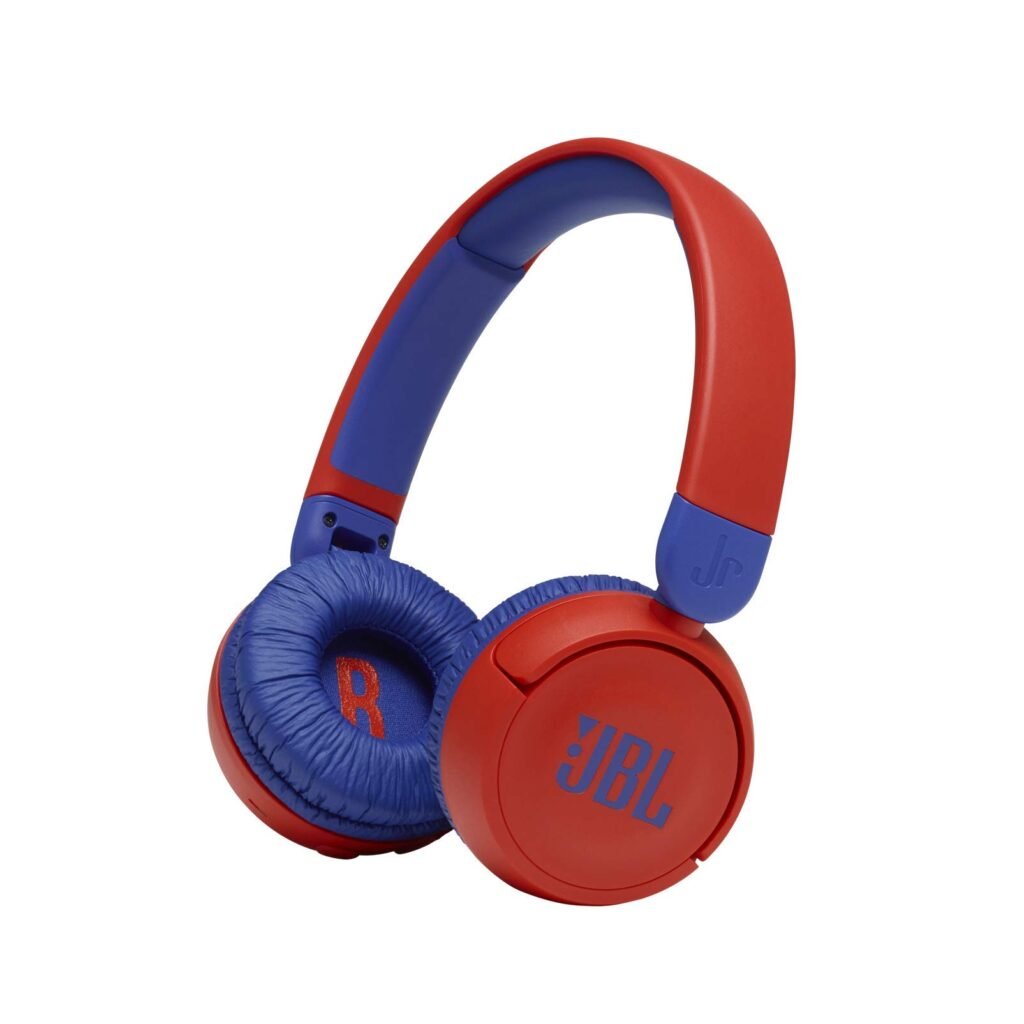
Why they’re a top pick: JBL has been a powerhouse in the audio industry for decades. They bring that legacy of sound engineering to the JR310BT, delivering their signature quality in a package that’s completely safe and designed for kids.
Key Features:
- JBL Safe Sound (<85dB): You get the quality and clarity JBL is known for, all while being safely locked at or below the 85 dB threshold.
- Massive 30-Hour Battery: This is a huge selling point. A single charge can last for days, meaning less hassle for parents and uninterrupted listening for kids on long trips. A quick 10-minute charge provides 2 hours of playtime.
- Simple, Kid-Friendly Controls: The buttons are large, intuitive, and easy for little hands to operate, empowering kids to manage their own music and calls.
- Compact and Portable: The headphones are lightweight and feature a foldable design, making them easy to pack up and take anywhere.
- Built-in Mic & Fun Stickers: Includes a microphone for clear communication and a sticker set so kids can add their own creative flair.
Perfect for: Brand-conscious families who trust JBL’s audio legacy and want the convenience of an extra-long wireless battery life.
4. LilGadgets Connect+ Pro: The Stylish and Shareable Wired Option
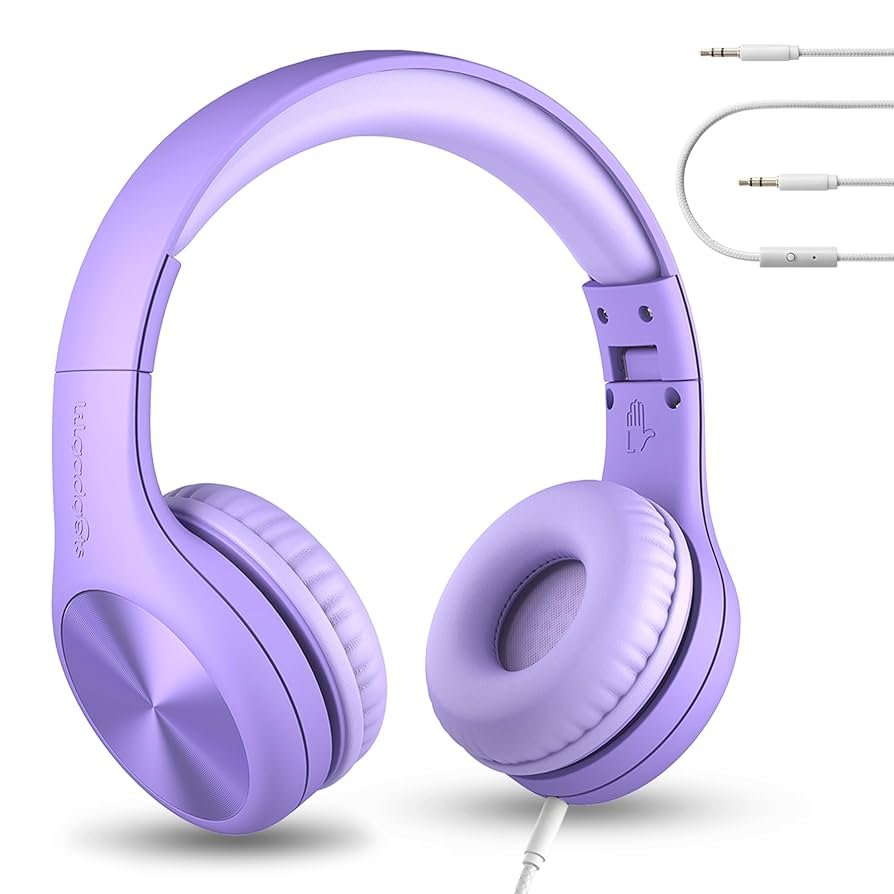
Why they’re a top pick: LilGadgets strikes a perfect balance between a premium, stylish aesthetic and rugged, kid-proof construction. Their Connect+ Pro model is a wired workhorse that’s particularly praised for its durability and sharing capabilities.
Key Features:
- Volume Limited to 93 dB: This limit is geared towards being audible in louder environments. It’s a great option for older kids, but for toddlers and preschoolers, an 85 dB limit is preferable.
- SharePort® Technology: Like the BuddyPhones, the integrated SharePort allows another headphone to daisy-chain for shared audio without needing a separate splitter.
- Built to Last: A metal frame, durable padding, and a premium braided nylon cable (that’s also tangle-resistant) make these headphones feel substantial and ready for years of use.
- SoftTouch™ Comfort: The breathable mesh earcups are designed for long-wearing comfort, reducing irritation and sweat.
- Sleek Design: Available in a range of colors, their design is a bit more understated and “grown-up,” which can be a big draw for pre-teens who have outgrown cartoonish designs.
Perfect for: Parents seeking an ultra-durable, battery-free wired option with a fantastic sharing feature, especially for older children who will appreciate the more mature design.
5. Onanoff Sound Bendy: The Indestructible Choice for Toddlers
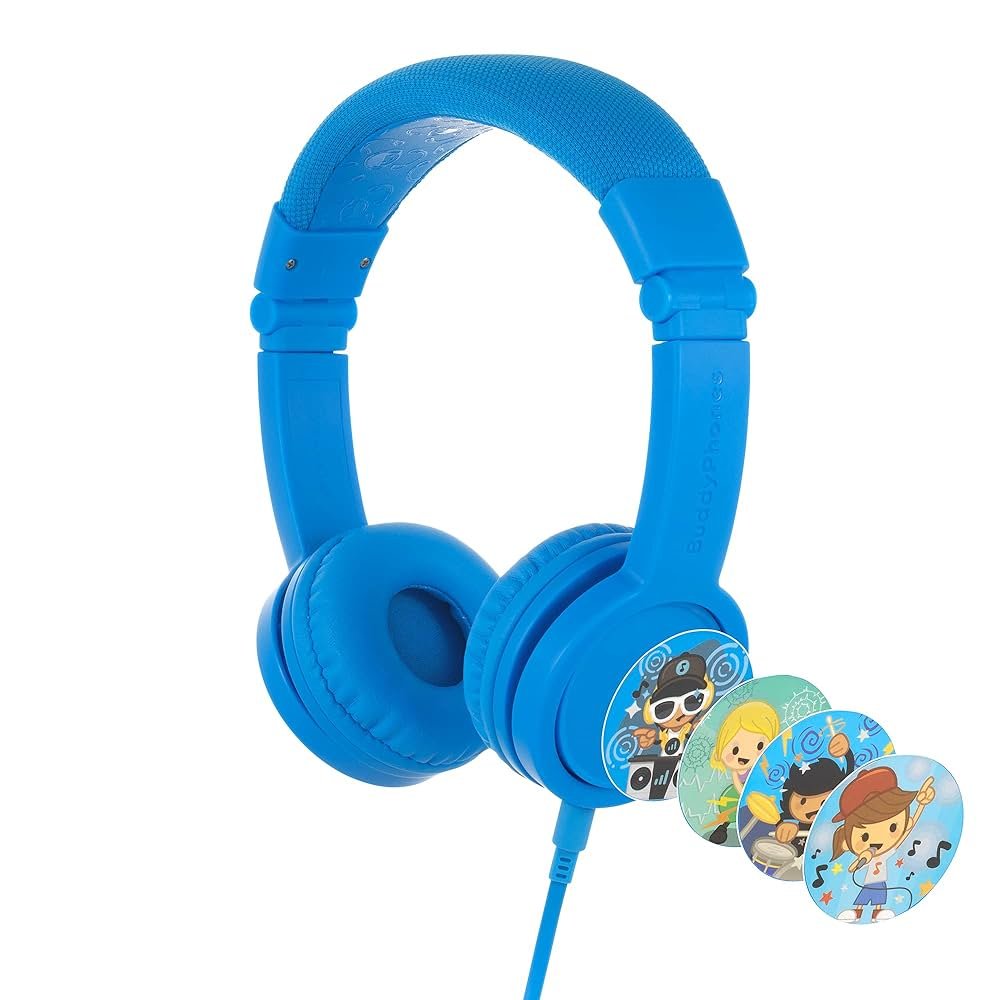
Why they’re a top pick: If your primary concern is a pair of headphones surviving a toddler, look no further. The Onanoff Sound Bendy prioritizes extreme flexibility above all else. They are, for all intents and purposes, unbreakable.
Key Features:
- Twistable, Bendable Frame: You can literally twist the headband into a pretzel, and it will bounce back to its original shape. This unique, flexible EVA foam construction is perfect for the youngest, most hands-on users.
- Strict 85 dB Volume Limit: Ensures the most sensitive ears are always protected.
- Plug-and-Play Simplicity: As a wired-only model, there are no batteries to charge or buttons to learn. It’s the ultimate simple and reliable solution.
- Ultra-Lightweight Comfort: Designed for the smallest heads, they are incredibly light and comfortable, with hypoallergenic ear cushions that are gentle on sensitive skin.
- Worry-Free Materials: Constructed from safe, BPA-free, and durable materials.
Perfect for: Toddlers, preschoolers, and any child who is particularly rough on their belongings. It’s the ultimate “peace of mind” purchase for parents of young children.
Beyond the Gear: How to Teach Your Child Safe Listening Habits
Buying the right headphones is step one. Step two is teaching the habits that will protect their hearing for a lifetime.
- Introduce the 60/60 Rule: A great guideline is to listen at no more than 60% of the device’s maximum volume for no longer than 60 minutes at a time.
- Encourage Listening Breaks: Teach them to take a 10-15 minute break every hour to give their ears a rest.
- Explain the “Why”: Talk to them in simple terms. “We use these special headphones to protect your super hearing so you can always enjoy your favorite songs and stories!”
- Lead by Example: Model good listening habits yourself. Keep your own music at a reasonable volume and show them that you also take breaks.
Frequently Asked Questions (FAQ) About Kid-Friendly Headphones
Here are answers to some of the most common questions parents have when choosing safe headphones for their children.
Q1: Can’t I just use regular adult headphones and tell my child to keep the volume low?
This is a common thought, but it’s risky for a few key reasons. First, children don’t always have the self-control or understanding to keep the volume at a safe level, especially when they’re engrossed in a movie or game. Second, the volume percentage on a device (like 50% on a phone) isn’t a reliable measure of actual decibel output. A dedicated pair of volume-limiting headphones provides a physical, unchangeable safety cap that protects their hearing no matter what, giving you true peace of mind.
Q2: Are wireless Bluetooth headphones safe for young children?
Yes, they are widely considered safe. Bluetooth technology uses very low-power, non-ionizing radio waves—similar to but even weaker than a standard Wi-Fi signal. Major international health organizations, including the World Health Organization (WHO), have found no established health risks from the low levels of radiofrequency energy used in Bluetooth devices. The convenience and freedom from tangled wires often make them a safer practical choice for active kids.
Q3: At what age can my child start using headphones?
Most audiologists and pediatricians recommend holding off on headphones for children under the age of 2. For toddlers (age 2-4), it’s best to limit use to specific situations, like air travel, and always under supervision. From age 4 and up, headphones become more practical for school and entertainment. The most important factors are ensuring the headphones fit properly and teaching good listening habits, like taking frequent breaks.
Q4: What’s the difference between ‘noise isolation’ and ‘active noise cancellation (ANC)’?
- Passive Noise Isolation is created by the physical design of the headphones. The well-fitted, padded earcups create a seal around the ear to physically block out external sounds, much like earmuffs do. Most of the kid-friendly headphones on our list use this method effectively.
- Active Noise Cancellation (ANC) is an electronic feature. It uses tiny microphones to listen to outside noise and then generates an opposite sound wave to “cancel it out.” While effective, some people find it creates a feeling of pressure. For most children, strong passive noise isolation is more than sufficient to provide clear audio without needing to raise the volume.
Q5: How should I clean my child’s headphones?
Keeping headphones clean is important for hygiene. First, ensure they are unplugged or turned off. Use a soft, slightly damp cloth (water only, or a very mild soap solution) to wipe down the headband and the outside of the earcups. For the ear cushions, wipe them gently and be careful not to let any liquid seep into the speaker components. Avoid using harsh chemicals, alcohol wipes, or abrasive cleaners. Let them air dry completely before the next use.
Q6: My child complains that their new safe headphones are “too quiet.” What should I do?
This is a common reaction, especially if they were previously used to listening at dangerously high volumes. The best approach is a combination of education and adjustment.
- Explain the “Why”: Gently remind them that these special headphones are designed to protect their “super hearing” so they can enjoy sounds for a long, long time.
- Check the Fit: Ensure the earcups are creating a good seal around their ears. A snug fit improves sound quality and blocks out more background noise, making the limited volume sound richer and clearer.
- Give It Time: Their ears will adjust to the new, safer volume level. Encourage them to use the headphones in a quieter room at first to help them appreciate the sound quality without the need for high volume.
An Investment in a Lifetime of Sound
In the end, choosing kid-friendly headphones is about more than just managing noise on a road trip. It’s a proactive, loving decision to protect one of your child’s most precious senses. It’s an investment in their ability to hear the teacher in a classroom, the nuances of a beautiful piece of music, and the voices of their loved ones for the rest of their lives.
The technology is here, and the options are fantastic. By selecting any of the models on this list, you’re giving your child a gift of both enjoyment and enduring health.
Ready to make the smart choice for your child’s auditory future? Invest in their hearing today. Explore our top-rated kid-friendly headphones and give yourself the peace of mind that comes with knowing they are listening safely. Also, don’t forget to subscribe to mindgearmen.com.



This site can be a stroll-via for the entire information you wanted about this and didn’t know who to ask. Glimpse here, and you’ll undoubtedly discover it.